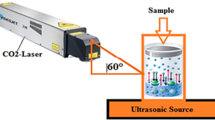Abstract
The well-known high pressure high temperature (HPHT) method has been used for preparing diamond since 1986. This research introduces a new method for preparing diamond by using the global Hummer method after changing two main agents, namely, the frequency of ultrasound waves and the exposure time of these waves. The frequency was increased to 40 kHz, while the exposure time was increased to 2 h. It was found that applying the Hummer method on graphene oxide with an ultrasound exposure time of 20 min and 2 h can result in graphene oxide and nanodiamond (ND), respectively. The resulting ND began to grow after it was left for 10 days. The spectral properties of the diamond were characterized by using Ultraviolet-visible (UV-Vis) and Raman. The UV-Vis showed that the absorption peak at 220 nm is within the ultraviolet region, while the bandgap was found to be 5.6. The Raman confirmed the presence of the functional group for the diamond at 1332 cm−1 wavenumber. Moreover, the morphology property of the diamond and stages of diamond formation have been visualized by using scanning electron microscope (SEM) and optical microscope.




Similar content being viewed by others
References
Tapia JL, Larios E, Bittencourt C, Yacaman MJ, Quintana M (2016) Carbon nano-allotropes produced by ultrasonication of few-layer graphene and fullerene. Carbon. 99:541–546
Harlow GE, Davies RM (2005) Diamonds. Elements. 1:67–70
Hemley RJ, Chen Y, Yan C (2005) Growing diamond crystals by chemical vapor deposition. Elements. 1:105–108
Kharissovaa OV, Kharisova BI, Valdésa JJR, Méndeza UO (2011) Ultrasound in Nanochemistry: recent advances. Synthesis and Reactivity in Inorganic, Metal-Organic, and Nano-Metal Chemistry 41:429–448
Flynn HG (1986) Method and means for converting graphite to diamond. United States Patent 4:341–563
Chen C, Yu B, Liu P, Wang L (2011) Investigation of nano-sized ZnO particles fabricated by various synthesis routes. Ceram Process Res 12:420–425
Mochalin VN, Shenderova O, Ho D, Gogotsi Y (2011) The properties and applications of nanodiamonds. Nat Nanotechnol 209:11–23
Khachatryan AK, Aloyan SG, May PW, Sargsyan R, Khachatryan VA, Baghdasaryan VS (2008) Graphite-to-diamond transformation induced by ultrasound cavitation. Diam Relat Mater 17:931–936
Panich AM, Shames AI, Sergeev NA (2013) Paramagnetic impurities in graphene oxide. Appl Magn Reson 44:107–116
Salem M, Bassily MA, Meakhail TA, TORII S (2016) Experimental Investigation on heat transfer and pressure drop characteristics of graphene oxide/water nanofluid in a circular tube. IPASJ Int J Mech Eng (IIJME) 4:12–22
Acknowledgements
We are sincerely thankful to Eng. Mohannad R. Ghanim for his useful help.
Author information
Authors and Affiliations
Corresponding author
Ethics declarations
Conflict of Interest
The authors declare that they have no conflict of interest.
Additional information
Publisher’s Note
Springer Nature remains neutral with regard to jurisdictional claims in published maps and institutional affiliations.
Rights and permissions
About this article
Cite this article
Abdul Hussien, A.M., Ghanim, R.R. & AL-Saedi, I.I. Graphene Oxide to Diamond Transformation by Ultrasound Waves. Plasmonics 16, 65–69 (2021). https://doi.org/10.1007/s11468-020-01251-2
Received:
Accepted:
Published:
Issue Date:
DOI: https://doi.org/10.1007/s11468-020-01251-2




